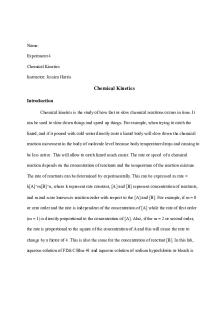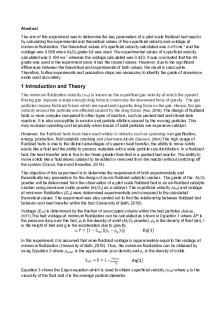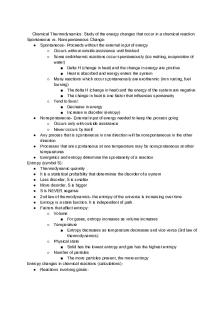Chemical Thermodynamics Lab Report PDF

| Title | Chemical Thermodynamics Lab Report |
|---|---|
| Author | Isabelle Issa |
| Course | general chemistry lab |
| Institution | University of Miami |
| Pages | 3 |
| File Size | 90.9 KB |
| File Type | |
| Total Downloads | 66 |
| Total Views | 159 |
Summary
Download Chemical Thermodynamics Lab Report PDF
Description
Chemical Thermodynamics: Heat of Formation of MgO(s) Laboratory Report By: Isabelle Issa
Introduction: In this lab, the purpose is to determine the enthalpy of formation of MgO (s). In order to do so, the experiment calls for the use of Hess’s law, in cases like these where measuring energy changes during a specific reaction is difficult or impossible. Hess’s law states that if a reaction is carried out in a series of step, delta H for the reaction will equal the sum of the enthalpy changes for individual steps. Thus, the reactions that have the capability to run in the laboratory can be used while measuring energy changed to find the enthalpy of formation of MgO(s). In addition to chemical composition, the energy content of a substance is important in determining its properties. The enthalpy of formation can be defined as the heat given off when one mole of a substance is prepared from its constituent elements in their standard states. This experiment calls for making a simple calorimeter and measuring the heat given off in the reaction between Mg and HCl and the reaction between MgO and HCl. To determine the heat of formation of MgO(s), the principle of state functions can be used. State functions refer to the enthalpies of the reaction and depend only on the initial and final states of the system and not on the path taken. Procedure: 1. Determination of the Heat of Formation of MgO(s): a. Set up the calorimeter as described by your teaching assistant. b. Prepare 250 mL of 1 M HCl from the 3 M stock solution. c. Use your graduated cylinder to transfer exactly 100 mL of the dilute HCl solution into the calorimeter Styrofoam cup. d. Clean a piece of Mg ribbon with steel wool and then weigh a piece of about 0.25 grams to the nearest 0.0001 g and record the exact weight. e. Wind the ribbon around the loop of the stirrer. f. Record the initial temperature of the HCl solution. g. Immerse the stirrer in the HCl and stir gently making certain that the Mg ribbon never comes above the surface of the HCl solution. h. Monitor the temperature rise and record the highest value reached. i. Repeat the value using MgO in place of Mg. j. Place exactly 100 mL of fresh acid solution in the Styrofoam cup. k. Accurately weigh out (to the nearest 0.0001 g) about 0.4 g of MgO and record the exact weight. l. Record the temperature prior to adding MgO and then add the solid. m. Stir until it is all dissolved and record the highest temperature reached. 2. Specific Heat of a Metal: a. Obtain a metal rod from your instructor. Record the number stamped on the rod in your data sheet (this is your unknown number, a number between 1 and 6). b. Use the analytical balance to determine the weight of the rod. Record the weight.
c. By means of the copper wire, suspend your unknown rod in a beaker of vigorously boiling water. d. Measure, as precisely as possible, 50.0 mL of water (graduated cylinder) at room temperature and transfer it completely to a clean, dry Styrofoam cup which is set inside another cup. e. Record the temperature of the water to the nearest 0.2 degrees Celsius. f. When the unknown has reached the temperature of the boiling water (after about 10 minutes) transfer it rapidly from the bath to the water in the cup. g. Swirl the cup gently and record the highest temperature reached to the nearest 0.2 degrees Celsius. h. Repeat the experiment and determine the average specific heat (note that the specific heat is a positive quantity) Equations: Determination of the Heat of Formation of MgO(s): Delta H of the Reaction = -Q/moles Delta HD = delta Hf (MgO)= delta HB – delta HC + (-68.3 kcal/mole). Heat = heat capacity x mass x temperature change = (1.0 cal/g degrees C) x (100 g) x (temperature change)
Specific Heat: Heat lost = - Heat gained Heat lost = sp.h. x no. grams x delta T for the metal Heat gained = no. grams x 1 cal/degree g x delta T for calorimeter and contents
Observations: Determination of the Heat of Formation of MgO (s): I. Part I.: a. Heat given off = -1.05 kcal b. Delta Hrxn = 107.23 kcal/mol II. Part II.: a. Heat given off = -0.23 kcal b. Delta Hrxn = 21.558 kcal/mol III. Part III: a. Calculated enthalpy of formation of MgO = 17.37 kcal/mol
b. Enthalpy of formation of MgO = 72.676 kJ/mol Specific Heat: Specific heat of metal = 0.1518 cal/degrees g Specific heat of metal= 0.1525 cal/ degrees g Average specific heat= 0.152 cal/ degrees g
Calculations:
Discussion/Conclusions: The purpose of this experiment was to use the fundamental principles of Hess’s law and thermodynamics to determine the heat of formation of magnesium oxide. A calorimeter (Styrofoam cup) was used to find the enthalpy of formation of MgO, which was calculated to be 72.676 kJ/mol. The values calculated during both trials of this portion of the experiment did present some disparities. However, this was only because the change in temperature values were much smaller in part II. than in part I. The specific heat capacity of the unknown metal rod was also found using the calorimeter. The unknown metal was determined to be aluminum. The average specific heat of the unknown metal rod in the experiment was determined to be 0.152 cal/degrees g. The specific heat of aluminum is 0.24 cal/g degrees Celsius, so the experiment logically concluded that aluminum was the unknown metal, seeing as how its specific heat was the closest in value to that calculated in the experiment. There is about a 0.09 cal/degrees g difference between the two values, which suggests that the data collected and the calculated numbers are valid and therefore, usable. Despite the validity of these results, however, it is still important to account for any errors that could have occurred during the duration of this experiment. An error may have occurred if the Mg strip was not thoroughly cleaned. This could have caused the weight to shift and be higher, which would then alter all subsequent results in the process. This can easily be prevented by not rushing this step and being as careful as possible. In addition, another possible source of error could pertain to the potential of some of the MgO spilling while being transported from the scale back to the table. The amount lost could cause the delta Hrxn to be slightly lower than the actual value. This can be avoided, however, by being careful and taking the time to perform this step properly....
Similar Free PDFs

Thermodynamics Lab Report Complete
- 10 Pages

Thermodynamics Lab Report
- 19 Pages

Chemical Kinetic Lab Report
- 2 Pages

Lab Report Chemical Composition
- 3 Pages

Chemical Kinetics - lab report
- 4 Pages

PDF Chemical Thermodynamics
- 173 Pages

Lab 11 Chemical Kinetics Report
- 4 Pages
Popular Institutions
- Tinajero National High School - Annex
- Politeknik Caltex Riau
- Yokohama City University
- SGT University
- University of Al-Qadisiyah
- Divine Word College of Vigan
- Techniek College Rotterdam
- Universidade de Santiago
- Universiti Teknologi MARA Cawangan Johor Kampus Pasir Gudang
- Poltekkes Kemenkes Yogyakarta
- Baguio City National High School
- Colegio san marcos
- preparatoria uno
- Centro de Bachillerato Tecnológico Industrial y de Servicios No. 107
- Dalian Maritime University
- Quang Trung Secondary School
- Colegio Tecnológico en Informática
- Corporación Regional de Educación Superior
- Grupo CEDVA
- Dar Al Uloom University
- Centro de Estudios Preuniversitarios de la Universidad Nacional de Ingeniería
- 上智大学
- Aakash International School, Nuna Majara
- San Felipe Neri Catholic School
- Kang Chiao International School - New Taipei City
- Misamis Occidental National High School
- Institución Educativa Escuela Normal Juan Ladrilleros
- Kolehiyo ng Pantukan
- Batanes State College
- Instituto Continental
- Sekolah Menengah Kejuruan Kesehatan Kaltara (Tarakan)
- Colegio de La Inmaculada Concepcion - Cebu








